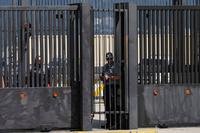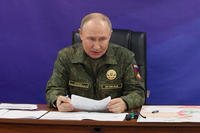The former Navy secretary's call to reactivate a numbered fleet in the Pacific to counter China's growing maritime power is still under consideration, a top military leader said this week.
Adm. John Aquilino, commander of U.S. Pacific Fleet, is studying the pros and cons of bringing back U.S. First Fleet, Adm. Phil Davidson, the head of Indo-Pacific Command, said Wednesday. The possible resurrection of the fleet, which was last active in the 1970s, was announced in November by then-Navy Secretary Kenneth Braithwaite.
Braithwaite said the goal was to base the future First Fleet between the Indian and Pacific oceans. Aquilino has been asked by Navy leadership to "look at some options for what First Fleet might do," Davidson told members of the House Armed Services Committee.
Read Next: As China Declares War with US Inevitable, Army General Highlights Need for Fighting Vehicles
"He's still in the process of developing what the concepts might be, what the impacts ... are and how it'll affect Seventh Fleet -- and some of our relationships out there as well," Davidson said.
Seventh Fleet, which is based in Japan, is the Navy's largest forward-deployed fleet and the only one in the Asia-Pacific region. It covers a huge area stretching from India down to Antarctica and up past Japan to the Kuril Islands.
The fleet has anywhere from 50 to 70 ships and submarines assigned to it throughout the year, but Davidson said demand for naval forces in the Asia-Pacific region is only likely to increase as China flexes its power in the region. The presence of an aircraft carrier in the Pacific is especially important, he said.
"There is no capability that we have that can substitute for an aircraft carrier, in my view," Davidson said.
The Navy used the command that would eventually become First Fleet from 1943 to 1973. If it comes back, experts told Stars and Stripes that Singapore or Australia could make good basing options.
Braithwaite said last year that a fleet for the Indo and South Asian region will reassure allies while making sure potential adversaries know the U.S. is committed to global presence to ensure freedom of the seas.
And this wouldn't be the only organizational change for the Navy as it faces new threats at sea. The service also changed the name of Fleet Forces Command to U.S. Atlantic Fleet, to better address the threat that Russia poses there.
"We will refocus our naval forces in this important region on their original mission -- controlling the maritime approaches to the United States and to those of our allies," Braithwaite said of that change.
-- Gina Harkins can be reached at gina.harkins@military.com. Follow her on Twitter @ginaaharkins.
Related: Navy Secretary Pitches 1st Fleet Revival in Western Pacific, Possibly Based in Singapore












